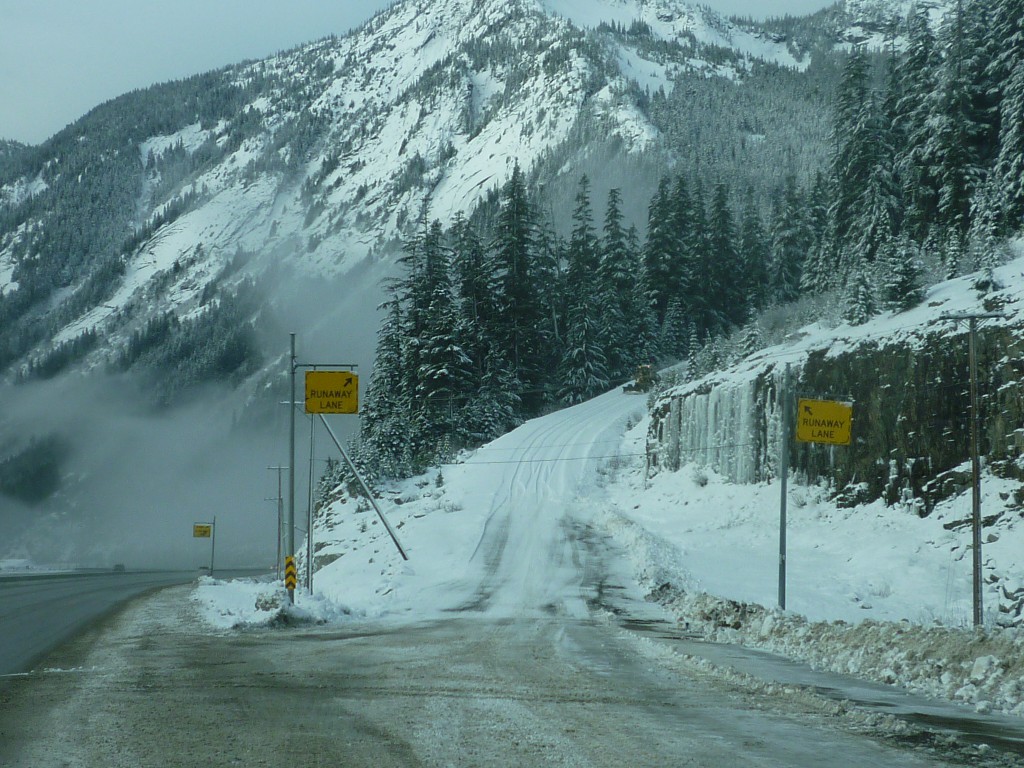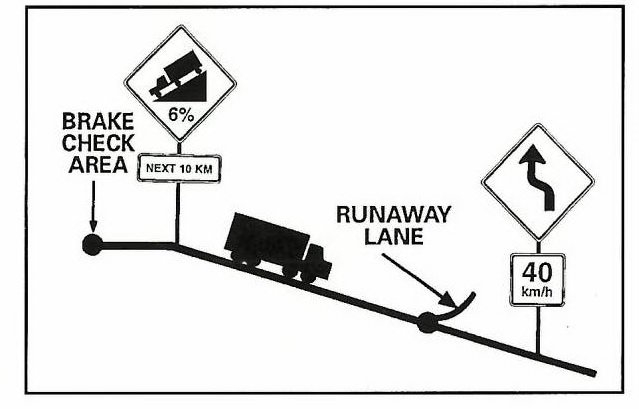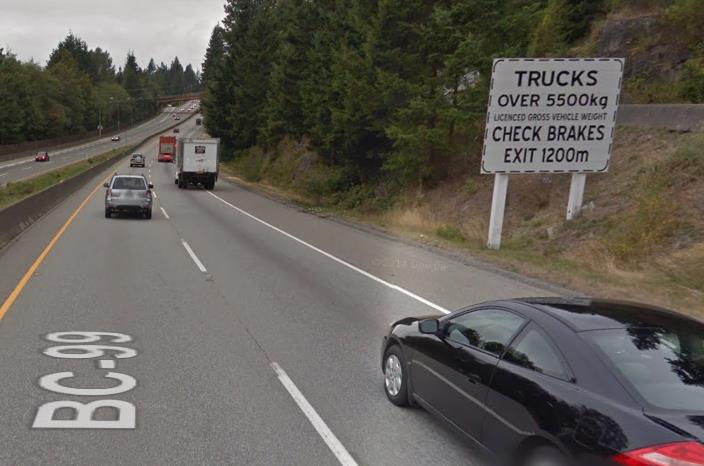 If you’ve ever driven down a mountain pass in British Columbia, you’ve likely looked up in awe at an off ramp rising up, up, up into… well, apparently nowhere.
If you’ve ever driven down a mountain pass in British Columbia, you’ve likely looked up in awe at an off ramp rising up, up, up into… well, apparently nowhere.
As the signs state, that is a runaway lane. In other words, it’s the road less travelled that you do not want to have to take. But, if you ever find yourself out of control down a hill, it’s the road you will be more than relieved to see.
BC’s steep, winding, mountainous terrain can be challenging for any driver, but especially for heavily loaded commercial trucks. Still, downhill runaways are preventable. Descending steep grades at an appropriate speed, with properly functioning brakes, is an essential part of being a professional driver.
4 Steps to Preventing a Runaway Truck
- Conduct a daily pre-trip inspection
A thorough pre-trip inspection gives you the most up-to-date information on the fitness of your vehicle. It’s also a good time to find out if an air line is likely to rupture when applying the brakes. - Confirm brakes are adjusted
When professional drivers see brake check signs (like the one shown below) they know that it’s the law to adjust their brakes before driving down steep grades, including checking the “slack” at each brake chamber. That’s why there are brake check facilities located throughout the province. The brakes on a commercial vehicle can only accurately be checked by physically pulling (with the use of a pry bar) on each slack adjuster.Even self-adjusting slack adjusters need to be checked, and if necessary, adjusted. Check with a certified mechanic for the correct procedure. - Plan your descent
 Information displayed on highway signs can help you plan your descent. This includes information about the severity of the grade, the recommended speed to negotiate sharp curves, and upcoming runaway lanes.In BC, signs with dashed borders provide information for heavy truck operators.
Information displayed on highway signs can help you plan your descent. This includes information about the severity of the grade, the recommended speed to negotiate sharp curves, and upcoming runaway lanes.In BC, signs with dashed borders provide information for heavy truck operators.

- Determine a safe descent speed
Select a speed that will let you travel down steep grades without having to brake continuously, which can cause overheating and braking power loss. An appropriate speed keeps the brakes ready to react when needed.
The runaway lane: a last resort
Runaway lanes are a final safety measure for when you lose braking power. Consider using a runaway lane if applying the brakes has little or no effect on slowing the speed of your vehicle.
If it feels like you have no brakes… don’t chance it – take action.
It’s extremely important to make the decision to use a runaway lane before your vehicle reaches an unmanageable descent speed.
Examples of runaway lanes in BC
Runaway lanes come in various lengths and grades, with different materials and features designed to stop out-of-control vehicles. Here are a couple types you can expect in BC.
Gravity Bed

This is the type of runaway lane that leads a truck up a slope. It uses a combination of gravity and a bed of gravel to slow the truck down and keep it from sliding backwards. You’ll notice these runaway lanes on the Coquihalla, for example.
Arrester Bed with Cable Nets or Gravel Bed

This type of runaway lane relies on a cable netting system and/or a gravel bed to slow down the truck on either a horizontal or descending grade. You’ll notice one of these runaway lanes at the Horseshoe Bay Ferry Terminal, for example.
It’s important to be familiar with runaway lanes, whether you’re a professional truck driver or an average driver. Brake loss is more common in commercial transport trucks, but it can happen to any vehicle. And, for obvious reasons, never park your vehicle in, or in front of, a runaway lane.
Hopefully, you will never need to use these roads less travelled. Remember: safety starts with regular vehicle inspections and smart downhill driving. Follow the tips in this blog, and you should be left rolling just fine.
Great job on explaining “what is brake checking.” Your post serves as a timely reminder for all of us to stay vigilant and avoid engaging in such reckless behavior while driving.
Thank you for this feedback, Wendy! We are glad that you found this post to be of value and we appreciate the comment.
Hello
I am looking for a used Runaway lane sign for a film project. The story has an educational element so people would have a better understanding of it’s intent.
Would you advise me as to where I can acquire one.
Good morning, K.C. – thanks for reaching out to us here. Our maintenance contractors do not make old signs available for sale but you can order a new sign, from one of our recognized suppliers if you like. Here is a list (in no particular order) for you to reach out to. These suppliers have a complete catalogue of ministry signs available for sale. Hope this is helpful.
Astrographic Industries Ltd. Tran Sign (1999) Ltd.
17855 – 66th Avenue 2920 Jacklin Road
Surrey, BC V3S 7X1 Victoria, BC V9B 3Y5
Toll Free 1-800-663-6551 Toll Free: 1-800-663-7157
Fax 604-596-1211 Fax: 250-474-6535
Email: jim@astrographic.com Email: Kevin@transign.com
Web: http://www.astrographic.com Web: http://www.transign.com
Empire Signworks Inc. Valley Traffic Systems Inc.
Unit 1 – 7167 Vantage Way 9770 – 199A Street
Delta, BC V4G 1K5 Langley, BC V1M 3C6
Toll Free 1-800-663-5698 Toll Free: 1-888-448-8886
Fax 604-946-5004 Fax: 604-513-3661
Email: roadsign@telus.net Email: gay@valleytraffic.ca
Web: http://www.valleytraffic.ca
ATS Traffic-British Columbia Ltd. Zumar Industries Inc.
Unit 202 – 20351 Duncan Way PO Box 44549
Langley, BC V3A 7N3 Tacoma, Washington, USA 98444
Phone: 1-800-720-1065 Toll Free: 1-800-426-7967
Fax: 604-530-9179 Fax: 253-536-8680
Email: sales-bc@atstraffic.ca Email: mgiese@zumar.com
Web: http://www.atstraffic.ca Web: http://www.zumar.com
Sherine Industries Ltd.
113-19433-96th Avenue
Surrey, BC V4N 4C4
Toll Free: 1-800-665-0566
Fax: 604-513-1890
Email: sales@sherineindustries.com
Web: http://www.sherine industries.com
Are you supposed to use these lanes before you lose control? Just curious as it was a question on one of my tests
Hi Jessica,
Yep. While these are built primarily for commercial drivers to use in the unfortunate event of brake control loss, all vehicles experiencing brake loss can use them.
We hope that this is helpful!
You assert “Even self-adjusting slack adjusters need to be… if necessary, adjusted”?
Routine adjustment, even rarely, is REALLY bad advice considering that the under-lying failure remains, and the purpose for mandating automatic slack adjusters has been by-passed. Some of these failures are BEST quantified by excess stroke, and ARE COMMONLY ignored after manual adjustment.
Hello Mr. Tinning,
The advice is still correct. If an autoslack is found to be out of adjustment, it should be manually adjusted prior to ascending the grade. You are also correct that an auto slack that has gone out of adjustment provably has internal issues or a lack of maintenance (grease) and needs to be inspected and or replaced.
What happens after the truck stops and starts rolling back?
How is a truck recovered from a runaway lane?
Hi Paul,
Thanks for your question about recovering trucks from runaway lanes. We do not perform heavy equipment rescue or towing. You would need to contact companies who do that work.
In B. C. how often in a typical year, do any runaway lanes get used?
Hi Dai,
Thanks for asking about how often runaway lanes get used, each year. Unfortunately, we do not have information tracking those numbers.
How runaway lanes are needed if you have a steep grade for 1 km
Hi Shellye,
We aren’t sure we clearly understand your question – are you asking why runaway lanes are needed on steep grade that lasts for 1 km?
The runaway lanes through cranbrook to Vancouver are not well plowed.
Thank you, Jeremy. Our maintenance contractors prioritize winter maintenance activities based on highway classifications (determined by traffic volume). Meanwhile, travelled lanes are dealt with first, with more time allowed to clear pullouts, parking areas, and other vehicle accessible portions within the right-of-way. That said, I will notify our local operations managers who oversee these areas.
I saw a lot of runaway lanes on my voyage from Lethbridge AB to the lower mainland of B.C. but one caught my attention along highway 3. This particular one has a really sharp turn to get into it since it’s partially blocked by a concrete based fencing type thing, I saw this somewhere between Salmo and Castlegar, just hate to be a trucker having to go into it with such a sharp turn in.
Thanks Ken,
I’ve passed your concerns along to the local district and the Commercial Vehicle Safety Enforcement (CVSE) branch.
I was rather surprised by the location of the new runaway lane at Galena Bay on Highway 23 – at the top of the hill immediately after the brake check (the old runaway lane at the bottom is now the location for the outhouses!). Doesn’t really seem to be much use there.
Hello Mr. Thomas.
Great question. An engineering analysis and evaluation in 2013/2014 showed that an arrestor bed at the top of the hill would be the best location. The arrestor bed runaway lane location was chosen after an analysis of the grade from the ferry terminal to a point approximately 6 km’s to the south (towards Nakusp). The analysis reviewed a number of different scenarios of truck speeds and consequences. Firstly, if a truck lost its brakes in advance of the brake check or near the brake check, the truck will not be able to negotiate the horizontal curves on the way to the terminal and will exit the highway prior to reaching the terminal. Secondly, if a truck uses the brake check, it will be able to safely proceed down the hill using its brakes. No brake fade should occur as the friction temperature will not get enough to cause brake fade or cause a loss of braking power. However, if such a condition was to occur, the truck would need to use the roadside ditch to slow down and avoid a collision with any queued traffic. For this reason, the clear zone concept has been applied to the highway with recoverable roadside slopes and breakaway lamp standards.
The ministry did consider a secondary runway lane at the bottom of the hill near the terminal but considering the terminal area is busy with cars and people, combined with the topographical constraints, it is much safer to build a clear zone concept.
Hugh Eberle
District Manager, Nelson